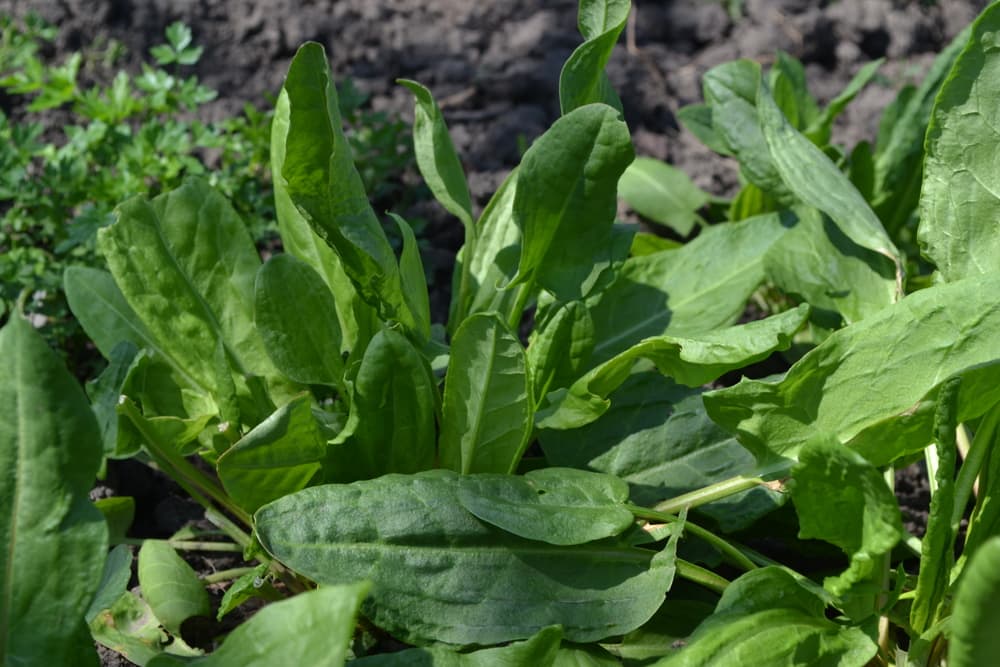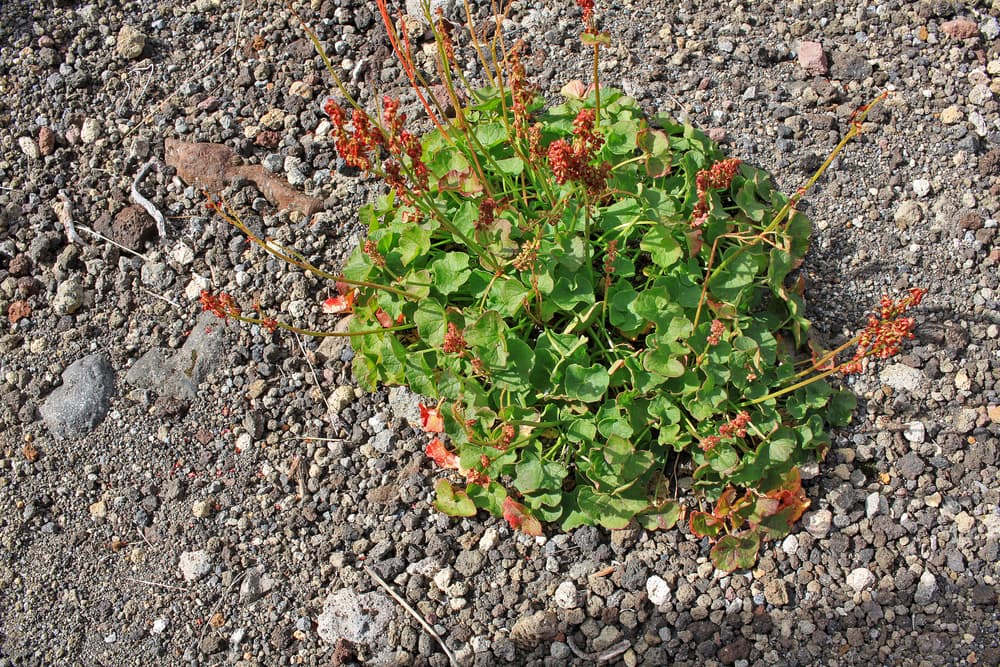English vs French Sorrel Explained, With 12 Interesting Varieties To Try And Grow

Reviewed By DAN ORI

Dan has over 27 years’ under his belt caring for plants and gardens. Working as a Horticultural Instructor and Consultant, he draws on a diverse range of experience that includes working as a Head Gardener, Tree Surgeon, Garden Centre Trouble Shooter, and writer of academic papers. Dan has a Level 3 Diploma in Horticulture and is currently a candidate for the RHS’s most prestigious award – The Master of Horticulture.
IN THIS GUIDE
SORREL GUIDES
Harvesting
Planting
Varieties
Several edible varieties of ‘Sorrel’ are found but these straddle two different genera, Rumex and Oxalis.
To compound the confusion, many a species in each genus is also informally known as ‘Dock’ with a preceding qualifier!
Rumex acetosa or Common Sorrel is the ‘Herb Sorrel’ or the Sorrel herb – it includes several varieties.
English vs French Sorrel
The Common Sorrel that is most ‘commonly’ used as a herb in the UK and that used to be grown in cottage gardens is called – not too surprisingly – ‘Garden Sorrel’.
It is called ‘English Sorrel’ in the US.
Then there is also a French Sorrel – in fact, there are two French Sorrels.
Both Sorrel De Belleville and Round-Leaved Sorrel are colloquially known as ‘French Sorrel’.
Many perennial species of Wood Sorrel that have clumping or creeping forms are of more value for their simple but exceedingly pretty small flowers, and for making lovely groundcover.

Among the various species and varieties of Herb Sorrel, several of the most useful ones are outlined underneath.
R. acetosa or Common Sorrel includes several varieties, all of which are dioecious.
It is a hardy plant.
1) Garden Sorrel

Botanical Name: Rumex acetosa
Native to the British Isles and grows wild in fields and meadows.
It has oblong, somewhat arrow-shaped, leaves with a notch at the base, and which are of a medium bright green colour.
The leaves vary in shape and size – the lower ones are bigger and broader and are stalked while the younger leaves are smaller and narrower and are sessile.
The plant grows to 50-80cm and has a spread of 10-30cm.
2) Belleville Sorrel

Botanical Name: R. acetosa ‘De Belleville’
Also a variety of R. acetosa, and it is the French French Sorrel.
Compared to Garden Sorrel leaves, this variety’s leaves are longer and more arrow-shaped. They are a bright emerald green.
Maturity or position of the respective leaves being the same, this herb’s flavour is milder and less acidic than that of Garden Sorrel.1Sorrel. (n.d.). Retrieved March 24, 2023, from https://academics.hamilton.edu/foodforthought/our_research_files/sorrel.pdf
3) Round-Leaved Sorrel

Botanical Name: R. scutatus
Also called French Sorrel because it grows wild in France and neighbouring regions.
This is a monoecious plant and it has broad, somewhat halberd-shaped or heart-shaped leaves.
The plant grows to only 30-45cm high.
It grows along the ground and has a clumping habit; the taste of the leaves is sharp and very acidic.
4) Sarcelle Blond Sorrel
Closely related to Sorrel de Belleville and is an old French cultivar.
It starts putting out leaves very early in spring.
Its leaves are even longer and narrower than those of Sorrel de Belleville.
Its leaves too have a mild, acidic flavour.
5) Fervent’s Large Sorrel
Another French variety.
Like Blonde de Lyon, its leaves emerge very early in spring; moreover, it produces abundantly.
The leaves are slightly blistered.
This variety too is a clever choice with respect to flavour.
6) Red-Veined Sorrel

Botanical Name: R. sanguineus
“If I had to recommend one sorrel it would be Red-Veined Sorrel, a beautiful edible that has so many culinary uses,” shares Master Horticulturist Dan Ori,
This variety has flat lettuce-like leaves of a brilliant green hue with prominent blood-red veins.
It grows to about 30cm and is native to Europe and Asia.
This Sorrel is a ‘triple play’, to use Baseball terminology:
- It tastes a little like lettuce so the young spring leaves can be eaten raw in salads.
- Older, basal leaves are good substitutes for spinach and kale.
- Third, it bears tiny red-coloured flowers in summer and is an excellent choice for an ornamental plant in shrubberies and rockeries mainly because of its very unusual and decorative foliage.
7) Patience Dock

Botanical Name: R. patientia
A very hardy species – this is the Sorrel that was used as a herb and a leafy green in Ancient Greece and Rome.
It is a tap-rooted perennial that grows to be a tall plant often exceeding 2 metres in height.
Rather than a herb it is more of a leafy green.
It puts out leaves with the first signs of spring and is still eaten in two or three countries on the Continent.
8) Arctic Dock
Botanical Name: R. arcticus
Arctic Dock or ‘Sour Dock’ is a perfectly hardy species that is indigenous to Alaska and the Arctic regions and grows even in the Arctic circle.
It has lanceolate leaves that are a part of the diet of the Eskimo People.2Rumex arcticus. (n.d.). Flora of the Canadian Arctic Archipelago. Retrieved March 24, 2023, from https://nature.ca/aaflora/data/www/pgruar.htm
In summer the plant bears lovely upright red panicles.
9) Indian Sorrel

Botanical Name: R. vesicarius
Bladder Dock has an upright form with ovate leaves.
It grows in the temperate and tropical zones of Asia.
The leaves are broadly oval.
They have a pleasantly sour taste and are distinctive for their succulence for which reasons they make for a very fine salad leaf.
10) Heartwing Sorrel
Botanical Name: R. hastatulus
Has some of the prettiest and also tastiest leaves – deep, bright green, and tart and tangy.
It grows wild in the Southern United States but is little known even in its native regions.
It attains a height of about 60cm, making it an excellent choice for the home garden.
11) Mountain Sorrel

Botanical Name: R. montanus
Includes three variants.
These plants are distinguished by their much larger leaves that can be up to 30cm and which are blistered to some or another degree.
These Sorrels’ leaves are just about the most highly acidic leaves of all.
12) Sheep Sorrel

Botanical Name: R. acetosella
This is not an edible herb and is more like a coarse weed; however, it is worth mentioning for three reasons.
It is a favourite fodder for sheep. Third, it is an invasive weed.
References
- 1Sorrel. (n.d.). Retrieved March 24, 2023, from https://academics.hamilton.edu/foodforthought/our_research_files/sorrel.pdf
- 2Rumex arcticus. (n.d.). Flora of the Canadian Arctic Archipelago. Retrieved March 24, 2023, from https://nature.ca/aaflora/data/www/pgruar.htm

